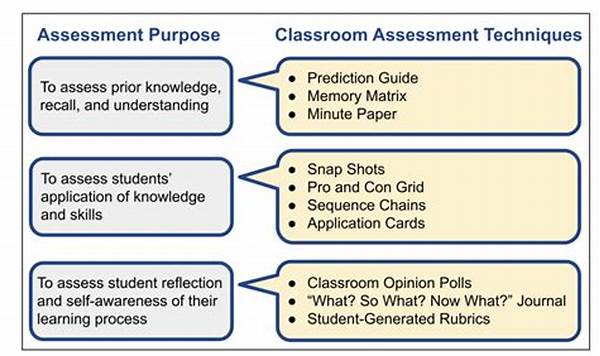In the contemporary educational landscape, the need for innovative and effective evaluation methods is paramount. Project-based student evaluation techniques represent a compelling approach that aligns with the dynamic requirements of modern education. As educators seek to foster critical thinking, creativity, and practical skills among students, these techniques serve as a bridge between theoretical knowledge and real-world application. This article delves into the various aspects of project-based student evaluation techniques, highlighting their importance, methodologies, and potential benefits.
Read Now : Effective Assessment Integration Techniques
Understanding Project-Based Student Evaluation Techniques
Project-based student evaluation techniques are rooted in the principles of experiential learning. These methods involve assessing students through their engagement in projects that require problem-solving, collaboration, and the application of knowledge. Unlike traditional evaluation methods that often rely on standardized tests, project-based evaluations offer a more nuanced understanding of a student’s abilities. By engaging in projects, students demonstrate their competencies in a context that mimics real-life scenarios. For example, a science student may conduct experiments and present findings, while an art student might create and exhibit original works. These techniques not only measure academic proficiency but also assess critical soft skills such as time management, teamwork, and communication. As educators increasingly recognize the limitations of traditional assessments, project-based student evaluation techniques emerge as a progressive alternative that addresses the needs of diverse learners.
Key Components of Project-Based Student Evaluation Techniques
1. Authentic Assessment: Project-based student evaluation techniques emphasize real-world applicability, ensuring that projects are relevant to students’ future professional or personal experiences.
2. Collaborative Learning: These techniques foster collaboration amongst students, enhancing their ability to work efficiently within a team.
3. Critical Thinking and Problem Solving: Projects are designed to challenge students, promoting critical analysis and innovative solutions.
4. Student-Centered Learning: Learners take ownership of their projects, guiding their own educational experiences and outcomes.
5. Reflective Practices: Students engage in reflection, allowing them to assess their own learning and growth over the course of the project.
Benefits of Implementing Project-Based Student Evaluation Techniques
Project-based student evaluation techniques offer myriad advantages for both educators and students. First, they encourage an active learning process where students are at the center of their educational journey. This shift from passive reception to active engagement enhances retention and understanding of the material. Additionally, the collaborative nature of these projects prepares students for the workforce, where teamwork and communication are indispensable. Moreover, the use of project-based student evaluation techniques allows educators to more accurately gauge a student’s practical skills and knowledge application, rather than merely assessing theoretical understanding through tests. This approach addresses different learning styles, accommodating both visual and hands-on learners. Consequently, project-based evaluations create more equitable educational opportunities, contributing to a more inclusive learning environment that caters to diverse student needs.
Detailed Exploration of Project-Based Student Evaluation Techniques
1. Integration with Curriculum: Projects should be seamlessly integrated into the existing curriculum to ensure relevance and uphold academic standards.
2. Clear Objectives and Expectations: Clearly defined objectives and transparent evaluation criteria are essential for guiding students.
3. Variety of Assessments: A combination of formative and summative assessments provides a comprehensive evaluation of student performance.
4. Use of Technology: Incorporating digital tools can enhance project outcomes and engage technologically savvy students.
Read Now : Decision-making In Editorial Teams
5. Interdisciplinary Approach: Projects that cross traditional subject boundaries encourage holistic learning.
6. Continuous Feedback: Regular feedback from instructors and peers helps students improve and refine their projects.
7. Flexibility and Adaptability: Flexibility in project parameters allows students to explore their interests while meeting learning goals.
8. Resource Management: Efficient use of resources teaches students about budgeting and project planning.
9. Cultural Relevance: Incorporating culturally relevant themes in projects helps in engaging a diverse student body.
10. Ethical Considerations: Projects should encourage ethical thinking and decision-making.
Challenges and Solutions in Project-Based Student Evaluation Techniques
Despite its many benefits, the implementation of project-based student evaluation techniques can present several challenges. One primary concern is the potential for unequal participation among group members. Some students may contribute more heavily than others, leading to disparities in individual evaluation. To mitigate this, educators can implement peer assessment mechanisms that hold each team member accountable. Additionally, assessing projects can be more time-consuming compared to traditional methods, requiring detailed rubrics and ongoing feedback. Instructors must be adequately trained to manage these assessments effectively. Furthermore, the resources required to facilitate projects, such as materials or technology, can strain institutional budgets. Strategic planning and partnerships with community stakeholders may alleviate some of these constraints. By addressing these challenges, institutions can successfully harness the power of project-based student evaluation techniques to foster a more dynamic and inclusive learning environment.
Conclusion of Project-Based Student Evaluation Techniques
In conclusion, project-based student evaluation techniques present a transformative approach to assessing student performance. By prioritizing real-world application, collaboration, and critical thinking, these methods fulfill the evolving demands of modern education. While challenges exist, they are not insurmountable with proper planning and resource management. As educational paradigms continue to shift, embracing project-based student evaluation techniques will be instrumental in preparing students for success beyond the classroom. These techniques not only enhance academic learning but also contribute to the holistic development of learners, equipping them with the skills necessary to thrive in an increasingly complex world. By continuing to explore and refine these evaluation methods, educators can ensure that the future of assessment aligns with the diverse needs and aspirations of students.
